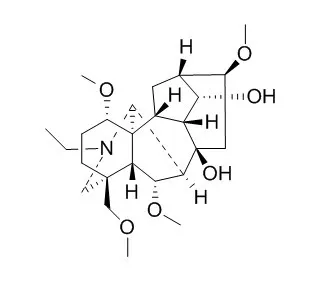| In vitro: |
| J Agric Food Chem. 2011 Apr 27;59(8):3701-6. | | Feeding deterrents from Aconitum episcopale roots against the red flour beetle, Tribolium castaneum.[Pubmed: 21417277] |
METHODS AND RESULTS:
The screening for insecticidal principles from several Chinese medicinal herbs showed that the ethanol extract of Aconitum episcopale roots possessed significant feeding deterrence against the red flour beetle, Tribolium castaneum . From the ethanol extract, six feeding deterrents were isolated by bioassay-guided fractionation. The compounds were identified as Chasmanine, crassicauline A, karacoline, sachaconitine, talatisamine, and yunaconitine from their spectroscopic data. Chasmanine, talatisamine, karacoline, and sachaconitine exhibited feeding deterrent activity against T. castaneum adults, with EC(50) values of 297.0, 342.8, 395.3, and 427.8 ppm, respectively.
CONCLUSIONS:
Yunaconitine and crassicauline A also possessed feeding deterrent activity against T. castaneum adults, with EC(50) values of 653.4 and 1134.5 ppm, respectively. | | Molecules. 2012 May 4;17(5):5187-94. | | Diterpenoid alkaloids from the Chinese traditional herbal [Pubmed: 22628040] |
METHODS AND RESULTS:
Ten diterpenoid alkaloids, including eight aconitine-type C₁₉-diterpenoid alkaloids and two hetisine-type C₂₀-diterpenoid alkaloids, were isolated from the secondary roots of Aconitum carmichaeli Debx., known as "Fuzi" in Chinese traditional herbal medicine. Their structures were established on the basis of their spectroscopic data and comparison with those of the literature. Among these alkaloids, Chasmanine, oxonitine and 15-acetylsongoramine were isolated for the first time from this medicinal plant.
CONCLUSIONS:
The cytotoxic activity of the alkaloids were tested against several cell lines by the MTT method in which aconitine, hypaconitine, mesaconitne and oxonitine were found to strongly inhibit the growth of the HePG2 cell line, which showed that the existence and quantity of the ester groups have a significant influence on the cytotoxicity of the diterpenoid alkaloids. | | Rsc Advances, 2015, 5(28):22209-16. | | A practical and novel “standard addition” strategy to screen pharmacodynamic components in traditional Chinese medicine using Heishunpian as an example[Reference: WebLink] |
METHODS AND RESULTS:
Results showed that hypaconitine, deoxyaconitine and Chasmanine were anti-inflammatory PCs in HSP with positive relations with HSP efficacy.
CONCLUSIONS:
Thus, SA was used to systematically evaluate the effect of chemical ingredients in TCM. The proposed method presents simple operation, strong feasibility and reliability, and provides a new approach for screening PCs in TCM in a manner that highlights the complexity and multi-component effects of TCM. |
|






 Cell. 2018 Jan 11;172(1-2):249-261.e12. doi: 10.1016/j.cell.2017.12.019.IF=36.216(2019)
Cell. 2018 Jan 11;172(1-2):249-261.e12. doi: 10.1016/j.cell.2017.12.019.IF=36.216(2019) Cell Metab. 2020 Mar 3;31(3):534-548.e5. doi: 10.1016/j.cmet.2020.01.002.IF=22.415(2019)
Cell Metab. 2020 Mar 3;31(3):534-548.e5. doi: 10.1016/j.cmet.2020.01.002.IF=22.415(2019) Mol Cell. 2017 Nov 16;68(4):673-685.e6. doi: 10.1016/j.molcel.2017.10.022.IF=14.548(2019)
Mol Cell. 2017 Nov 16;68(4):673-685.e6. doi: 10.1016/j.molcel.2017.10.022.IF=14.548(2019)